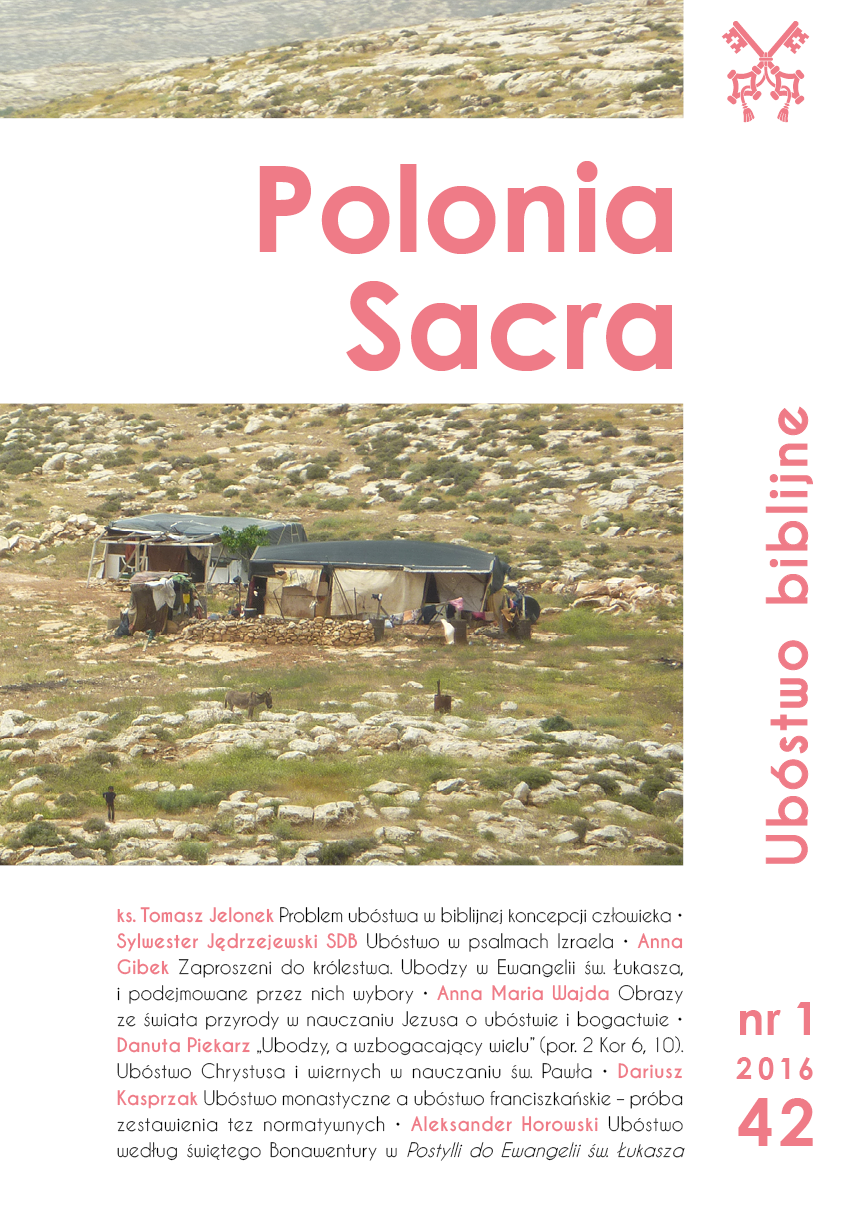Obrazy ze świata przyrody w nauczaniu Jezusa o ubóstwie i bogactwie
DOI:
https://doi.org/10.15633/ps.1592Słowa kluczowe:
ubóstwo, bogactwo, Jezus, fauna, floraAbstrakt
Obecność licznych przedstawicieli świata zwierząt i roślin na kartach Nowego Testamentu, często połączona z opisem cech charakterystycznych dla ich wyglądu lub sposobu życia czy wykorzystania ich przez człowieka, związana jest z posługiwaniem się przez Jezusa językiem obrazu. Równocześnie należy podkreślić, że ten bogaty świat przyrody jest dla Mistrza z Nazaretu narzędziem pomocnym w przekładaniu orędzia Boga na język ludzki. Dlatego poznanie znaczenia i symboliki zwierząt i roślin pojawiających się na kartach Pisma Świętego pozwala współczesnemu człowiekowi lepiej zrozumieć perykopy biblijne, w których są one przywoływane. W Nowym Testamencie występują opisy, w których Chrystus dla zilustrowania swojej nauki o ubóstwie i bogactwie nawiązuje do życia zwierząt. Przykładem tego są słowa Jezusa: „Lisy mają nory i ptaki powietrzne – gniazda, lecz Syn Człowieczy nie ma miejsca, gdzie by głowę mógł oprzeć” (Mt 8, 20). W swym nauczaniu na ten temat Jezus odwołuje się także do ptaków: „Przypatrzcie się ptakom w powietrzu: nie sieją, nie żną i nie zbierają do spichlerzy, a Ojciec wasz niebieski je żywi” (Mt 6, 26). Powyższe słowa świadczą o tym, że słuchacze Jezusa dobrze musieli znać te stworzenia, a zwłaszcza sposób zdobywania pokarmu oraz gnieżdżenia się. Natomiast Jezusowe odniesienie do mola ubraniowego podkreśla znikomość ziemskich bogactw. Zniszczenie ubrań przez mole na terenach biblijnych nie było sporadyczne, ale było czymś, co, biorąc pod uwagę czas, musiało się stać, jak zapisano w słowach Chrystusa: „Nie gromadźcie sobie skarbów na ziemi, gdzie mól i rdza niszczą i gdzie złodzieje włamują się, i kradną” (Mt 6, 19 i Łk 12, 33).Bibliografia
Anonymus, Atlas biblijny, Warszawa 1990.
Cansdale G., Animals of Bible lands, Sydney–Toronto–Auckland–Cape Town 1970.
Chouraqui A., Życie codzienne ludzi Biblii, przekł. L. Kossobudzki, Warszawa 1995.
Daniel-Rops H., Życie w Palestynie w czasach Chrystusa, przekł. J. Lasocka, Warszawa 2001.
Encyklopedia zwierząt. Ssaki, red. A. Pressley, tłum. E. Świątkowska, P. Świątkowski, Warszawa 1991.
Ferguson W.W., The mammals of Israel, Jerusalem 2002.
France P., An encyclopedia of Bible animals, Tel Aviv 1986.
Heide M., The domestication of the camel : biological, archaeological and inscriptional evidence from Mesopotamia, Egypt, Israel and Arabia, and literary evidence from the Hebrew Bible, „Ugarit-Forschungen, Internationales Jahrbuch für die Altertumskunde Syrien-Palästinas”, Bd 42 (2010), s. 331–382.
Jelonek T, Hospicjum św. Aleksandra newskiego, „Ziemia Święta”, nr 1 (77) 2014, s. 22–25.
Kawollek W., Falk H., Podróż po biblijnych ogrodach. Informacje o roślinach oraz wskazówki dotyczące ich uprawy, tłum. K. Kwiecień, Poznań 2005.
Kudasiewicz J., Jezus historii a Chrystus wiary, Lublin 1987.
Leksykon zwierząt od A do Ż, red. B. Zasieczna, Warszawa 1992.
Lurker M., Słownik obrazów i symboli biblijnych, tłum. K. Romaniuk, Poznań 1989.
Mickiewicz F., Ewangelia według św. Łukasza, rozdziały 1–11. Wstęp. Przekład z oryginału. Komentarz, cz. 1, Częstochowa 2011 (Nowy Komentarz Biblijny).
Mickiewicz F., Ewangelia według św. Łukasza, rozdziały 12–24. Wstęp. Przekład z oryginału. Komentarz, cz. 2, Częstochowa 2012 (Nowy Komentarz Biblijny).
Paciorek A., Ewangelia według św. Mateusza, rozdziały 1–13. Wstęp. Przekład z oryginału. Komentarz, cz. 1 poprawiona, Częstochowa 2005 (Nowy Komentarz Biblijny).
Paz U., Eshbol Y., Birds in the land of the Bible, Herzila [b.r.w.].
Pismo Święte Starego i Nowego Testamentu w przekładzie z języków oryginalnych, opracował Zespół Biblistów Polskich z inicjatywy Benedyktynów Tynieckich, Poznań 2000.
Sandner H., Owady. Zwierzęta świata, Warszawa 1989.
Słownik tła Biblii, red. J. I. Packer, M. C. Tenney, przekł. Z. Kościuk, Warszawa 2007.
Szczepanowicz B., Mrozek A., Atlas zwierząt biblijnych. Miejsce w Biblii i symbolika, Kraków 2007.
Szczepanowicz B., Wesołowska-Kowalska B., Moda w Biblii. Odzież, obuwie, nakrycia głowy, fryzury oraz kosmetyki i ozdoby, Kraków 2011.
Świat zwierząt, red. H. Grabarczyk, Warszawa 1986.
Świat zwierząt, red. L. Korbel, Warszawa 1989.
Trudne fragmenty Biblii, red. Kaiser W.C. Jr i in., tłum. L. Bigaj, Warszawa 2011.
Wajda A. M., Szkarłat i purpura w Biblii, „Studia Leopoliensia” 5 (2012), s. 123–130.
Wąsowski A., Biblijno-teologiczny wymiar bramy, Kraków 2014.
Wielki słownik frazeologiczny PWN z przysłowiami, red. A. Kłosińska, E. Sobol, A. Stankiewicz, Warszawa 2005.
Włodarczyk Z., Rośliny biblijne. Leksykon, Kraków 2011.
Pobrania
Opublikowane
Numer
Dział
Licencja
Autorzy publikujący w czasopiśmie udzielają jego wydawcy zgody o następującej treści:
- Autor zachowuje autorskie prawa majątkowe do utworu, a jednocześnie udziela wydawcy czasopisma zgody na jego pierwszą publikację w wersji drukowanej i wersji online na licencji Creative Commons Uznanie autorstwa 4.0 Międzynarodowe oraz zgody na wykonywanie opracowań, w tym przekładów.
- Autor ma możliwość udzielania zgody niewyłącznej na opublikowanie utworu w wersji, która ukazała się w czasopiśmie (np. zamieszczenia go w repozytorium instytucjonalnym lub opublikowania w książce), wraz z informacją o jego pierwszej publikacji w czasopiśmie.
- Autor może umieścić swój utwór online (np. w repozytorium instytucjonalnym lub na swojej stronie internetowej) jeszcze przed zgłoszeniem utworu do czasopisma.

